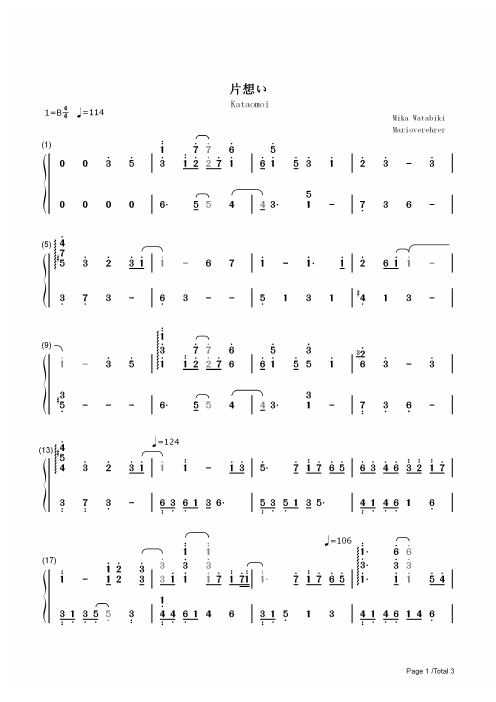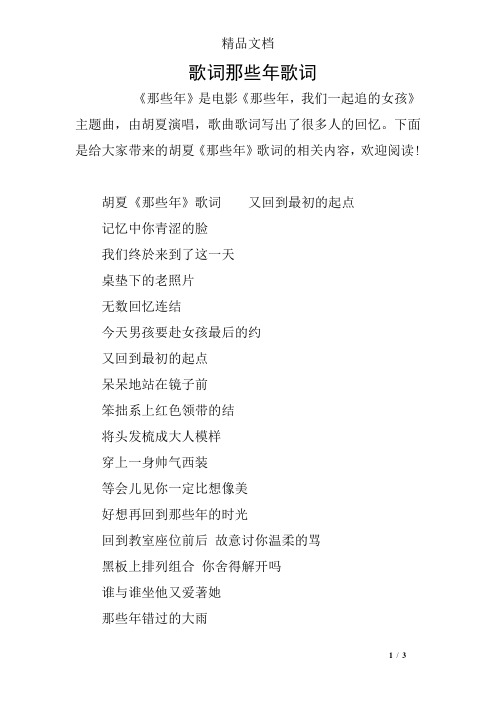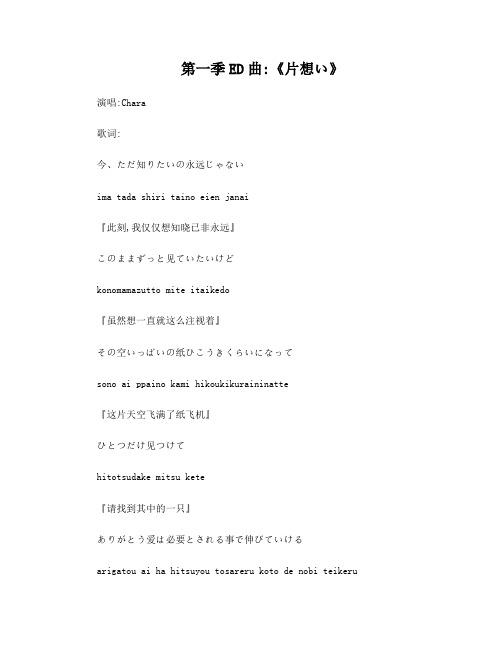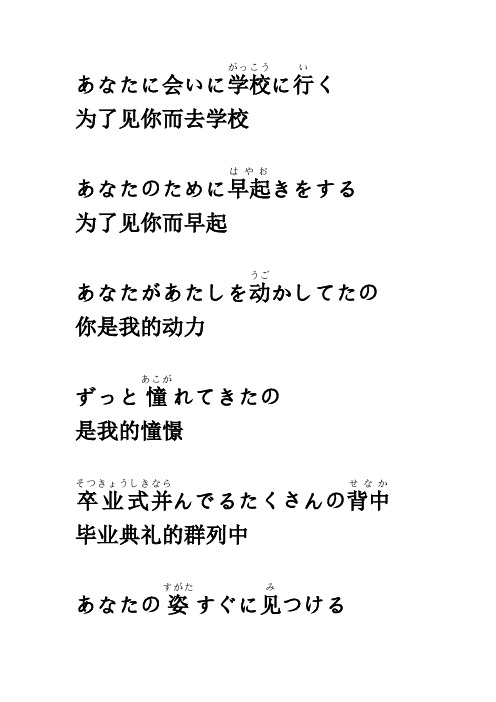好想告诉你_歌词
那些年歌词

好想拥抱你
拥抱错过的勇气
曾经想征服全世界
到最后回首才发现
这世界滴滴点点全部都是你
那些年错过的大雨
那些年错过的爱情
好想告诉你
告诉你我没有忘记
那天晚上满天星星
平行时空下的约定
再一次相遇我会紧紧抱着你
紧紧抱着你
那些年错过的大雨
那些年错过的爱情
好想拥抱你
回到教室座位前后
故意讨你温柔的骂
黑板上排列组合
你舍得解开吗
谁与谁坐他又爱着她
那些年错过的大雨
那些年错过的爱情
好想拥抱你
拥抱错过的勇气
曾经想征服全世界
到最后回首才发现
这世界滴滴点点全部都是你
那些年错过的大雨
那些年错过的爱情
好想告诉你
告诉你我没有忘记
那天晚上满天星星
那些年
作词:九把刀
作曲:木村充利
演唱:胡夏
又回到最初的起点
记忆中你青涩脸
我们终於来到了这一天
桌垫下的老照片
无数回忆连结
今天男孩要赴女孩最后的约
又回到最初的起点
呆呆地站在镜子前
笨拙系上红色领带的结
将头发梳成大人模样
穿上一身帅气西装
等会儿见你一定比想像美
好想再回到那些年的时光
平行时空下的约定
再一次相遇我会紧紧抱着你
紧紧抱着你
又回到最初的起点
呆呆地站在镜子前
笨拙系上红色领带的结
将头发梳成大人模样
穿上一身帅气西装
等会儿见你一定比想像美
好想再回到那些年的时光
陈奕迅 歌词

你迷人的魔力 我如梦奇遇 爱不可思议
唔 妙不可语 喔 我们在
白白净净的湖面 在海芋的季节
开满着美若天仙的海芋
缓缓慢慢的夏天 在热恋的季节
我坐在湖边开始轻描淡写
我坐在湖边开始轻描淡写
李媛希版本:
初夏的来临 也溢出了俏皮的气息
走过你来时的路
想像著没我的日子
你是怎样的孤独
拿著你 给的照片
熟悉的那一条街
只是为了你的画面
我们回不到那天
你会不会忽然的出现在街角的咖啡店
我会带著笑脸回首寒喧和你坐著聊聊天
我多麼想和你见一面
看看你最近改变不再需说从前
只是寒暄对你说一句
只是说一句
好久不见
总为你忐忑为你心软
毕竟相爱一场
不要谁心里带着伤
我可以永远笑着扮演你的配角
在你的背后自己煎熬
我没有非要一起到老
我可以不问感觉继续为爱讨好
冷眼的看着你的骄傲
若有情太难了想别恋要趁早
就算迷恋你的拥抱
忘了就好
爱已至此怎样的说法都能成为理由
还记得湖畔曾与你相遇
甜甜蜜蜜的暧昧 在热恋的季节
还记得你的笑容无比的甜
初夏的来临 也溢出了俏皮的气息
在暑气充斥的季节里 你晶莹剔透的带着凉意
你在天南星 气质非凡的好有活力
轻轻柔柔的想念 在单恋的季节
还记得湖畔曾与你相遇
甜甜蜜蜜的暧昧 在热恋的季节
我在这样的爱情里看见的
是我们的软弱
我可以永远笑着扮演你的配角
在你的背后自己煎熬
如果你不想要想退出要趁早
动漫歌词1

目录鬼束千寻--月光 (2)Olivia--A little pain (3)【NANA】ED1 (3)【好想告诉你】ED2 (5)PLANET - ラムジ (6)土屋ゕソナ--stand by me (7)【NANA】ED5 (7)OLIVIA -- Shadow Of Love (8)【NANA】插曲 (9)NICO海贼团--梦に形はないけれど (10)「この青空に约束を― ~ようこそつぐみ寮へ~」ED (12)Ruppina --FAITH (13)「海贼王」ED10 (13)奥华子--变わらないもの(不变的事物) (14)鬼束ちひろ- Infection (17)D-51--フゔミリゕ (18)【家庭教师ヒットマンREBORN!】ED16 (18)光冈昌美--Last cross (20)【家庭教师ヒットマンREBORN! 】OP5 (20)Galileo Galilei --青い栞(蓝书签) (22)「〙の日见た花の名前を仆达はまだ知らない。
」OP (22)secret base~君がくれたもの~你给我的所有~ (25)「〙の日见た花の名前を仆达はまだ知らない。
」ED (25)松田聖子--青い珊瑚礁 (26)Lia--青空 (27)【AIR】OP (27)Lia--夏影 (28)【AIR】ED (28)茶太--夏影 (29)[AIR]小满角色歌 (30)清水翔太--Home (31)7!!--ババ (35)[君と仆。
]OP (35)沢井美空--なきむし。
(36)[君と仆。
]ED (36)安室奈美恵--Fight Together (39)【海贼王】OP14 (39)麦わらの一味--ビンクスの酒 (41)「海賊王」插曲 (41)KAN--愛は勝つ (42)大槻真希--Memories (43)【海贼王】ED1 (43)矢口真里--風をさがして (44)[海贼王]OP12 (44)Aimer--六等星の夜 (45)[未来都市NO。
钢琴谱 片想い-好想告诉你ED 双手简谱_共3张(全)

伝えたい 彼が積み上げた想いの頂上 見えない私かLeabharlann はね その世界の中で私は何になれるの?
ただ知りたいの 永遠じゃない このままずっと見ていたいけど その空いっぱいの紙ひこうきぐらいになって 泣き出しそうよ
《片想い》是日本动画《好想告诉你》第一季片尾曲。由Chara演唱。
根据日本漫画家椎名轻穗创作的少女漫画《好想告诉你》改编的动画作品。共两季,第一季于2009年10月 6日-2010年3月30日放送,共25话;第二季于2011年1月4日-2011年3月29日放送,共12话。该漫画收到了 观众一致好评,并获得多项奖项。
2人がもう少し 認めあえば 少しだけ見つめて ゆれてる愛の花
片想い歌词:
作词:Chara 作曲:Chara 演唱:Chara
今、ただ知りたいの 永遠じゃない このままずっと見ていたいけど その空いっぱいの紙ひこうきぐらいになって ひとつだけ見つけて ありがとう 愛は必要とされる事で伸びていける 笑って私が2人の距離を楽しめたらいいのに
「分からない」それが答えなんだって シャボン玉飛ばそう 空までは きっと屆かないうちに壊れちゃう
佐藤美和(Chara)出生于1968年1月13日的琦玉县川口市,丈夫是浅野忠信,他们的女儿叫浅野堇。当 Chara才两岁还在学说话时,已经是位对音乐十分敏感的女孩。 于是她的父母买了一个玩具钢琴给她。四 岁时她就开始学真正的钢琴。 小学一年级时,她发表了第一首创作的歌曲「SAYONARA」。
歌词下方是片想い钢琴谱,欢迎大家使用。
那些年歌词《那些年我们一起追过的女孩》主题曲

那些年歌词《那些年我们一起追过的女孩》主题曲引导语:歌曲那些年是由胡夏演唱的,是《那些年我们一起追过的女孩》主题曲。
以下是的相关歌曲信息,供大家参考!歌词又回到最初的起点记忆中你青涩的脸我们终于来到了这一天桌垫下的老照片无数回忆连结今天男孩要赴女孩最后的约又回到最初的起点呆呆地站在镜子前笨拙系上红色领带的结将头发梳成大人模样穿上一身帅气西装等会儿见你一定比想像美好想再回到那些年的时光回到教室座位前后故意讨你温柔的骂黑板上排列组合你舍得解开吗谁与谁坐他又爱着她那些年错过的大雨那些年错过的爱情好想拥抱你拥抱错过的勇气曾经想征服全世界到最后回首才发现这世界滴滴点点全部都是你那些年错过的大雨那些年错过的爱情好想告诉你告诉你我没有忘记那天晚上满天星星平行时空下的约定再一次相遇我会紧紧抱着你紧紧抱着你那些年错过的大雨那些年错过的爱情好想拥抱你拥抱错过的勇气曾经想征服全世界到最后回首才发现这世界滴滴点点全部都是你那些年错过的大雨那些年错过的爱情好想告诉你告诉你我没有忘记那天晚上满天星星平行时空下的约定再一次相遇我会紧紧抱着你紧紧抱着你剧情介绍影片开始介绍沈佳宜的地方,胡家玮和沈佳宜有一段关于“太极峡谷”的对话,很多人可能没有明白究竟是什么意思。
我感觉这是对后面沈佳宜要求柯景腾陪他所做的铺垫,她并不是害怕,只是想多管管柯景腾的学习,也许从她让柯景腾晚上留校开始,她就已经对柯景腾萌发了一点感情。
海报当然,沈佳宜最明显的恋爱标志,就是从考完试以后,虽然她没有输,但是她还是扎起了马尾,因为他知道柯景腾喜欢看她扎马尾。
而雨夜吵架到婚礼,沈佳宜就再也没有扎过马尾,这足以证明她也是很喜欢柯景腾的。
二人吵架分手以后,阿和与沈佳宜在咖啡厅里约会,沈佳宜看到外面的情侣从吵架到和好的笑容,证明如果那候如果柯景腾真的软一些,跟她道歉的话,也许二人还能继续在一起,可理想往往很美好,结局却是如此凄凉。
而且二人分手后,柯景腾路过打电话的地方,我们可以看到那张自由格斗赛的海报已经被撕下来,柯景腾也是如此后悔,二人因为误会而没有走到一起[4]。
爱的天堂的歌词

爱的天堂的歌词
求爱爱的天堂的歌词,那么就和小编我一起去看看吧!下面是店铺!让我来帮你们查找关于爱的天堂的歌词的信息吧,希望能对你有用哦!
爱的天堂的歌词
阿桑古卡 - 爱的天堂
专辑:《爱的天堂》
沉醉的夜里我遇见了你
在我的心里难忘记
我的心全部被你占据
好想告诉你我已深深爱上你
你说你愿意和我在一起
如今你到底在哪里
我的心依然在痴迷
好想告诉你我一直在等着你
我听别人唱着那卓玛姑娘
我听别人说着你温柔善良
风儿吹着花儿花儿飘着香
每天每夜都浮现在我的心上
我常常的想你会来到我身旁
陪我度过寂寞的夜
陪我去流浪
甜甜的笑容纯纯的目光
我的梦想就住在你的天堂
爱的天堂的演唱者信息
阿桑古卡
民族:藏族,来自于安多迭部草原的雪域男儿,
推出了两张个人专辑《茶马古道》,《西藏男儿》;《通往天路的哈达》,《爱的天堂》;其中歌曲有《男人心》《茶马古道》《爱的天堂》等。
好想告诉你 歌词

轻抚过脸颊的微风
让呼吸变得深沉
迂回曲折的眼泪
赋予名字的明天
交织成一条未来的轴线
如此天真无邪的感情
和绽放微笑的相遇之日
必将在心中呵护成长
跨越过断断续续的日子
给予我无数的初体验
只想将这份心意 告诉你
放学后的黄昏下
望着前面谈笑的你
我默默自语
品味着从未体会的心情
就意味着再见
我也要说出 心中的一切
如此天真无邪的感情
和绽放微笑的相遇之日
必将在心中呵护成长
我要一点点学会长大成人
超越只会憧憬着你的自己
想和你紧密相连
马上将这份心意 告诉你
来自幻樱字幕组。
在我心中的你
与你心中的我之间
当未来的轮廓线 渐渐缠在一起
拥抱着雨过天晴的芬芳
胸怀着梦幻般的秘密心事
多少次因为有你才破涕为笑
要是我能抛开重重的心绪
飞快扑到你的怀中该多好
只想将这份心意 告诉你
明明面对着最为在意的你
为何从前的我却更在意自己会受伤
即使这一句话说出口
系がってゆけ 届け
放课后の夕暗
笑え君の背中
密かな嗫き
触れた事の无い思いの中
仆の中の君と
君の中の仆上がりの街の匂いと
梦见たいな秘密胸に抱いて
何度も泣きそうになってまた笑う
考えるよりずっと早く
その胸に飞び込めたらいい
系がってゆけ 届け
何よりも大事な君の前で
好想告诉你OP是きみにとどけ 。
日文歌词是。
优しい阳だまりに
チャイムがディレイする
六年级必唱曲目 歌词

1.给书包减肥大人们都喜欢叫我小鬼可是我已经有点驼背肩上的书包实在太重了噢压得我好累好累好累老师说外面的世界很美我只能在梦里和它相会肩上的书包实在太重了噢压得我好累好累好累噢谁给书包减肥噢谁给书包减肥让我象小鸟一样轻松地去飞噢谁给书包减肥噢谁给书包减肥让我象小鸟一样轻松地去飞大人们都喜欢叫我小鬼可是我已经有点驼背肩上的书包实在太重了噢压得我好累好累好累老师说外面的世界很美我只能在梦里和它相会肩上的书包实在太重了噢压得我好累好累好累噢谁给书包减肥噢谁给书包减肥让我象小鸟一样轻松地去飞噢谁给书包减肥噢谁给书包减肥让我象小鸟一样轻松地去飞噢谁给书包减肥噢谁给书包减肥给我两点白云青山和绿水噢谁给书包减肥噢谁给书包减肥给我两点白云青山和绿水噢谁给书包减肥噢谁给书包减肥给我兰天白云青山和绿水噢谁给书包减肥噢谁给书包减肥给我兰天白云青山和绿水和绿水和绿水2.同一首歌鲜花曾告诉我你怎样走过大地知道你心中的每一个角落甜蜜的梦啊谁都不会错过终于迎来今天这欢聚时刻水千条山万座我们曾走过每一次相逢和笑脸都彼此铭刻在阳光灿烂欢乐的日子里我们手拉手啊想说的太多星光洒满了所有的童年风雨走遍了世界的角落同样的感受给了我们同样的渴望同样的欢乐给了我们同一首歌阳光想渗透所有的语言风儿把天下的故事传说同样的感受给了我们同样的渴望同样的欢乐给了我们同一首歌阳光想渗透所有的语言风儿把天下的故事传说同样的感受给了我们同样的渴望同样的欢乐给了我们同一首歌同一首歌3阳光总在风雨后人生路上甜苦和喜忧愿与你分担所有难免曾经跌倒和等候要勇敢的抬头谁愿常躲在避风的港口宁有波涛汹涌的自由愿是你心中灯塔的守候在迷雾中让你看透阳光总在风雨后乌云上有睛空珍惜所有的感动每一份希望在你手中阳光总在风雨后请相信有彩虹风风雨雨都接受我一直会在你的左右4. 那些年-胡夏词:九把刀曲:木村充利又回到最初的起点记忆中你青涩的脸我们终于来到了这一天桌垫下的老照片无数回忆连结今天男孩要赴女孩最后的约又回到最初的起点呆呆地站在镜子前笨拙系上红色领带的结将头发梳成大人模样穿上一身帅气西装等会儿见你一定比想像美好想再回到那些年的时光回到教室座位前后故意讨你温柔的骂黑板上排列组合你舍得解开吗谁与谁坐他又爱著她那些年错过的大雨那些年错过的爱情好想拥抱你拥抱错过的勇气曾经想征服全世界到最后回首才发现这世界滴滴点点全部都是你那些年错过的大雨那些年错过的爱情好想告诉你告诉你我没有忘记那天晚上满天星星平行时空下的约定再一次相遇我会紧紧抱著你紧紧抱著你又回到最初的起点呆呆地站在镜子前笨拙系上红色领带的结将头发梳成大人模样穿上一身帅气西装等会儿见你一定比想像美好想再回到那些年的时光回到教室座位前后故意讨你温柔的骂黑板上排列组合你舍得解开吗谁与谁坐他又爱著她那些年错过的大雨那些年错过的爱情好想拥抱你拥抱错过的勇气曾经想征服全世界到最后回首才发现这世界滴滴点点全部都是你那些年错过的大雨那些年错过的爱情好想告诉你告诉你我没有忘记那天晚上满天星星平行时空下的约定再一次相遇我会紧紧抱著你紧紧抱著你那些年错过的大雨那些年错过的爱情好想拥抱你拥抱错过的勇气曾经想征服全世界到最后回首才发现这世界滴滴点点全部都是你那些年错过的大雨那些年错过的爱情好想告诉你告诉你我没有忘记那天晚上满天星星平行时空下的约定再一次相遇我会紧紧抱著你紧紧抱著你5.挥着翅膀的女孩当我还是一个懵懂的女孩遇到爱不懂爱从过去到现在直到他也离开留我在云海徘徊明白没人能取代他曾给我的信See me flyI'm proud to fly up high不能一直依 e人给我拥戴Believe me I can flyI'm singing in the sky就算风雨覆w我也不怕重来我已不是那个懵懂的女孩遇到爱用力爱仍信真爱风雨来不避开谦把头低下来像沙t来去天地只为寻一个奇迹See me flyI'm proud to fly up high生命已经打开我要那种精彩Believe me I can flyI'm singing in the sky你曾经对我说做勇敢的女孩我盼有一天能和你相骄傲地对著天空说是藉著你的风Let me flyI'm proud to fly up high生命已经打开我要那种精彩Believe me I can flyI'm singing in the sky你曾经对我说做勇敢的女孩我不会独单因为你都在6.我相信詞:劉虞瑞曲:陳國華唱:楊培安想飛上天,和太陽肩並肩世界等著我去改變想做的夢從不怕別人看見大聲歡笑讓你我肩併肩何處不能歡樂無限拋開煩惱勇敢的大步向前我就站在舞台中間我相信我就是我我相信明天我相信青春沒有地平線在日落的海邊在熱鬧的大街我相信自由自在我相信希望我相信伸手就能碰到天有你在我身邊讓生活更新鮮每一刻都精采萬分,i do believe 想飛上天,和太陽肩並肩世界等著我去改變拋開煩惱勇敢的大步向前我就站在舞台中間我相信我就是我我相信明天我相信青春沒有地平線在日落的海邊在熱鬧的大街我相信自由自在我相信希望我相信伸手就能碰到天有你在我身邊讓生活更新鮮每一刻都精采萬分,i do believe 我相信 I BELIVE我相信我就是我我相信明天我相信青春沒有地平線在日落的海邊在熱鬧的大街我相信自由自在我相信希望我相信伸手就能碰到天有你在我身邊讓生活更新鮮每一刻都精采萬分,i do believe7.左手右手歌手:杨沛宜专辑:喜羊羊与灰太狼之虎虎生威当困难来临的时候请你举起你的左手左手代表着方向它不会向困难低头当遇见挫折的时候请你举起你的右手右手代表着希望它不会为挫折发愁当左手拍响右手我们的步伐就有节奏当右手拍响左手我们的力量就有源头当你的手拉着我的手团结的力量彼此感受有方向有决心有节奏一起牵着手向前走当困难来临的时候请你举起你的左手左手代表着方向它不会向困难低头当遇见挫折的时候请你举起你的右手右手代表着希望它不会为挫折发愁当左手拍响右手我们的步伐就有节奏当右手拍响左手我们的力量就有源头当你的手拉着我的手团结的力量彼此感受有方向有决心有节奏一起牵着手向前走当你的手拉着我的手团结的力量彼此感受有方向有决心有节奏一起牵着手向前走8.妈妈那年还没长大常常让你牵挂是我不好你担心了吧懵懂很不听话也曾顶嘴吵架我的脾气你没办法你一个人沉默撑着家任岁月在你额头刻划你说爱是唯一的解答那皱纹是代价斑白的发是惩罚妈妈辛苦为家你别再让泪流下我会照顾这个家亲爱的妈妈休息你辛苦了没想过天会塌总要你等一下有谁多晚都等我回家伤了你的气话无意说的谎话你都微笑说算了吧你一个人沉默撑着家任岁月在你额头刻划你说爱是唯一的解答那皱纹是代价斑白的发是惩罚妈妈辛苦为家你别再让泪流下我会照顾这个家亲爱的妈妈休息你辛苦了我知道你累现在换我来背我一定不让你后悔我让未来很美亲爱的妈妈请别再流下眼泪那皱纹是代价斑白的发是惩罚妈妈辛苦为家你别再让泪流下我会照顾这个家亲爱的妈妈休息你辛苦了你真是辛苦了妈妈妈妈你不用哭了妈妈妈妈不要再哭了9. 彩虹背后有道彩虹一直划在我的梦中陪伴我淋过雨水吹过风当暖暖的阳光洒满晴朗的天空我就会绽放笑容有道彩虹一直划在我的梦中陪伴我淋过雨水吹过风当暖暖的阳光洒满晴朗的天空我就会绽放笑容总在心中有种莫名的感动有一天我会飞到最高的天空小小的梦想在这茫茫人海之中每一天辛勤地播种我相信在未来某一天我会收获所有的光荣就算我像颗流星划过夜空至少对得起每一分钟10.冬天的故事曲 : 于逸尧词 : 于逸尧杨千桦沉迷在冬天气氛看白昼烟囱升起一片云看着繁星铺满冬青树身可听到远方乐韵难道是冬季气温每件毛衣都挨得很靠近每条围巾都贴近望路上行行脚印这样新飘雪在拥抱行人用寒意将瑟缩身影靠近再亲近凝在冬天街角北风之中想要取暖就拥抱情人凭情意叫每片雪花稍等停留白色的景致里宁静地与爱侣相拥热吻明明在冰冷温度中但为何紧张得一脸微红发现有丝丝暖意在流动双颊也有点热烘其实是多么冀盼快入冬借助树影飘霜交织美梦在严寒中不觉冻实在未能叫暖意落空11.光阴的故事----罗大佑春天的花开秋天的风以及冬天的落阳忧郁的青春年少的我曾经无知的这么想风车在四季轮回的歌里它天天地流转风花雪月的诗句里我在年年的成长生命与告别光阴的故事改变了一个人就在那多愁善感而初次等待的青春发黄的相片古老的信以及褪色的圣诞卡年轻时为你写的歌恐怕你早已忘了吧过去的誓言就象那课本里缤纷的书签刻划着多少美丽的诗可是终究是一阵烟生命与告别光阴的故事改变了两个人就在那多愁善感而初次流泪的青春遥远的路程昨日的梦以及远去的笑声再次的见面我们又历经了多少的路程不再是旧日熟悉的我有着旧日狂热的梦也不是旧日熟悉的你有着依然的笑容生命与告别光阴的故事改变了我们就在那多愁善感而初次回忆的青春12.手拉手又名:心手相连演唱:黑鸭子Music----看圣火映红天空我们感到心儿在一起跳动快让我们昂首挺胸辉煌时刻将会永恒在心中到永远我们手拉手把世界走遍让我们共同创造一个美好家园我们手拉手心与心相连万水重重阻隔我们心相连到永远手拉手Music----每一次我们相见我们感到心中燃烧着火焰举起手伸向天边清晨宁静能让生活和谐无限到永远我们手拉手把世界走遍让我们共同创造一个美好家园我们手拉手心与心相连万水重重阻隔我们心相连到永远手拉手我们手拉手把世界走遍让我们共同创造一个美好家园我们手拉手心与心相连万水重重阻隔我们心相连到永远手拉手13.蜗牛词曲:周杰伦演唱:周杰伦该不该搁下重重的壳寻找到底哪里有蓝天随着轻轻的风轻轻地飘历经的伤都不感觉疼我要一步一步往上爬等待阳光静静看着它的脸小小的天有大大的梦想重重的壳裹着轻轻地仰望我要一步一步往上爬在最高点乘着叶片往前飞小小的天流过的泪和汗总有一天我有属于我的天我要一步一步往上爬在最高点乘着叶片往前飞任风吹干流过的泪和汗我要一步一步往上爬等待阳光静静看着它的脸小小的天有大大的梦想我有属于我的天任风吹干流过的泪和汗总有一天我有属于我的天14.我最响亮演唱:许飞灯光和花火一起闪亮也亮不过我的梦想我旅途的开场我沿路的徽章风沙搁浅的希望时光让脸庞渐渐发光风雪把悲伤轻轻吹亮被淋湿的翅膀才拥有穿越过那暴风雨的力量曾经的我想唱就唱我最响亮这一年夏天有最感动的阳光你给我梦想我勇敢往前闯风吹雨打拍拍肩膀现在的我想唱就唱我最响亮这一年夏天有最温暖的目光记忆的远方我披戴的荣光照进天窗擦亮梦想我最响亮灯光和花火一起闪亮也亮不过我的梦想我旅途的开场我沿路的徽章风沙搁浅的希望时光让脸庞渐渐发光风雪把悲伤轻轻吹亮被淋湿的翅膀才拥有穿越过那暴风雨的力量曾经的我想唱就唱我最响亮这一年夏天有最感动的阳光你给我梦想我勇敢往前闯风吹雨打拍拍肩膀现在的我想唱就唱我最响亮这一年夏天有最温暖的目光记忆的远方我披戴的荣光照进天窗擦亮梦想曾经的我想唱就唱我最响亮这一年夏天有最感动的阳光你给我梦想我勇敢往前闯风吹雨打拍拍肩膀现在的我想唱就唱我最响亮这一年夏天有最温暖的目光记忆的远方我披戴的荣光照进天窗擦亮梦想我最响亮15.放轻松别让我的双肩压的太重也许我的脚步会变得轻松让我们的心情学会流浪让我们的青春感受从容你让我坐的时候我真想动你让我动的时候我就会懵在我懵的时候我总要醒而当我醒来以后我还有梦放轻松我们放轻松好让我的心灵去吹风放轻松我们放轻松就让我的年龄会做梦放轻松我们放轻松好让我的心灵去吹风放轻松我们放轻松就让我的年龄会做梦你让我坐的时候我真想动你让我动的时候我就会懵在我懵的时候我总要醒而当我醒来以后我还有梦放轻松我们放轻松好让我的心灵去吹风放轻松我们放轻松就让我的年龄会做梦放轻松我们放轻松好让我的心灵去吹风放轻松我们放轻松就让我的年龄会做梦给我一片天空一片蓝蓝的天空我就是那潇潇洒洒的鹰给我一片草地一片青青的草地我就使那自由自在的风噢—放轻松我们放轻松好让我的心灵去吹风放轻松我们放轻松就让我的年龄会做梦放轻松我们放轻松好让我的心灵去吹风放轻松我们放轻松就让我的年龄会做梦16.阳光年华花苗圃的黑板将我的青春绿化,上下课的铃声将我的幻想收发。
十首学生喜欢的歌歌词

1、手掌心一乾而盡愛恨嗔癡的幻影我敬你一杯一乾二淨的黎明我在南極憧憬你的北極星我等你不信心心不相印你是天意你是噠噠的馬蹄滾滾了我的紅塵苦苦追尋冰天雪地一寸光陰一寸心一朵曇花一朵雲一朵雪花一朵夢境一一捧在手掌心一顆塵埃一菩提一顆流星一個你一心一意捧在手掌心七世夫妻只是神話的魔鏡第七夕只能再等一世紀你是天地你是風雨你是晴你是溫柔的叛逆逆轉我的一年四季一寸光陰一寸心一朵曇花一朵雲一朵雪花一朵夢境一一捧在手掌心一顆塵埃一菩提一顆流星一個你一心一意捧在手掌心偏偏我越抱越緊偏偏我越愛越貪心偏偏要愛到萬箭穿了心才死心左手掌握著空心右手掌握著癡心十指緊扣一本心經刻骨銘心著苦心可不可以不甘心可不可以不認命如果可以拿我換給你2、我一个人走或许再见是该死的念头说不出口至少自尊没让我更难受别再问候以为真真假假都已看透从不轻信承诺厮守可伤过的痛过的我向谁去说还是放了说好不分的手还是在相遇当初的街头幸福却分在两个路口你向左我向右我们变成了最好的朋友这次成全了你想要的自由大不了到最后我一个人走你是我心中残存的毒瘤回不了头已经遗忘该如何笑的脸渐渐变瘦你已经不再是我的所有却还有温度停在胸口可相爱的深爱的你该怎么说还是放了说好不分的手还是在相遇当初的街头幸福却分在两个路口你向左我向右我们变成了最好的朋友这次成全了你想要的自由大不了到最后我一个人走剩下的路该怎么走男人的泪该怎么流这份爱到最后一句爱你却哽住了喉还是放了说好不分的手还是在相遇当初的街头幸福却分在两个路口你向左我向右我们变成了最好的朋友这次成全了你想要的自由大不了到最后我一个人走3、如果这都不算爱是否爱就得忍耐不问该不该都怪我没能耐转身走开难道牺牲才精彩伤痛才实在要为你留下泪来才证明是爱如果这都不算爱我有什么好悲哀谢谢你的慷慨是我自己活该如果这都不算爱我有什么好悲哀你只要被期待不要真正去爱Oh no!还要怎样的表白才不算独白都怪我没能耐转身走开难道牺牲才精彩伤痛才实在要为你留下泪来才证明是爱你的感情太易割爱把未来转眼就删改我的心却为你空白了一块如果这都不算爱我有什么好悲哀谢谢你的慷慨是我自己活该如果这都不算爱我有什么好悲哀你要的是崇拜并不是谁的爱Oh no!4、愿得一人心曾在我背包小小夹层里的那个人陪伴我漂洋过海经过每一段旅程隐形的稻草人守护我的天真曾以为爱情能让未来只为一个人关了灯依旧在书桌角落的那个人变成我许多年来纪念爱情的标本消失的那个人回不去的青春忘不了爱过的人才会对过往认真只愿得一人心白首不分离这简单的话语需要巨大的勇气没想过失去你却是在骗自己最后你深深藏在我的歌声里只愿得一人心白首不分离这清晰的话语嘲笑孤单的自己盼望能见到你却一直骗自己遗憾你听不到我唱的这首歌多想唱给你曾在我背包小小夹层里的那个人陪伴我漂洋过海经过每一段旅程隐形的稻草人守护我的天真曾以为爱情能让未来只为一个人关了灯依旧在书桌角落的那个人变成我许多年来纪念爱情的标本消失的那个人回不去的青春忘不了爱过的人才会对过往认真只愿得一人心白首不分离这简单的话语需要巨大的勇气没想过失去你却是在骗自己最后你深深藏在我的歌声里只愿得一人心白首不分离这清晰的话语嘲笑孤单的自己盼望能见到你却一直骗自己遗憾你听不到我唱的这首歌只愿得一人心白首不分离这简单的话语需要巨大的勇气没想过失去你却是在骗自己最后你深深藏在我的歌声里只愿得一人心白首不分离这清晰的话语嘲笑孤单的自己我很想你却一直骗自己遗憾你听不到我唱的这首歌多想唱给你5、大海从那遥远海边慢慢消失的你本来模糊的脸竟然渐渐清晰想要说些什么又不知从何说起只有把它放在心底茫然走在海边看那潮来潮去徒劳无功想把每朵浪花记清想要说声爱你却被吹散在风里猛然回头你在那里如果大海能够唤回曾经的爱就让我用一生等待如果深情往事你已不再留恋就让它随风飘远如果大海能够带走我的哀愁就像带走每条河流所有受过的伤所有流过的泪我的爱请全部带走茫然走在海边看那潮来潮去徒劳无功想把每朵浪花记清想要说声爱你却被吹散在风里猛然回头你在那里如果大海能够唤回曾经的爱就让我用一生等待如果深情往事你已不再留恋就让它随风飘远如果大海能够带走我的哀愁就像带走每条河流所有受过的伤所有流过的泪我的爱请全部带走如果大海能够唤回曾经的爱就让我用一生等待如果深情往事你已不再留恋就让它随风飘远如果大海能够带走我的哀愁就像带走每条河流所有受过的伤所有流过的泪我的爱请全部带走6、后来后来我总算学会了如何去爱可惜你早已远去消失在人海后来终于在眼泪中明白有些人一旦错过就不在栀子花白花瓣落在我蓝色百褶裙上爱你你轻声说我低下头闻见一阵芬芳那个永恒的夜晚十七岁仲夏你吻我的那个夜晚让我往后的时光每当有感叹总想起当天的星光那时候的爱情为什么就能那样简单而又是为什么人年少时一定要让深爱的人受伤在这相似的深夜里你是否一样也在静静追悔感伤如果当时我们能不那么倔强现在也不那么遗憾你都如何回忆我带着笑或是很沉默这些年来有没有人能让你不寂寞后来我总算学会了如何去爱可惜你早已远去消失在人海后来终于在眼泪中明白有些人一旦错过就不再你都如何回忆我带着笑或是很沉默这些年来有没有人能让你不寂寞后来我总算学会了如何去爱可惜你早已远去消失在人海后来终于在眼泪中明白有些人一旦错过就不再后来我总算学会了如何去爱可惜你早已远去消失在人海后来终于在眼泪中明白有些人一旦错过就不再永远不会再重来有一个男孩爱着那个女孩7 胡夏- 那些年又回到最初的起点记忆中你青涩的脸我们终於来到了这一天桌垫下的老照片无数回忆连结今天男孩要赴女孩最後的约又回到最初的起点呆呆地站在镜子前笨拙系上红色领带的结将头发梳成大人模样穿上一身帅气西装等会儿见你一定比想像美好想再回到那些年的时光回到教室座位前後故意讨你温柔的骂黑板上排列组合你舍得解开吗谁与谁坐他又爱着她那些年错过的大雨那些年错过的爱情好想拥抱你拥抱错过的勇气曾经想征服全世界到最後回首才发现这世界滴滴点点全部都是你那些年错过的大雨那些年错过的爱情好想告诉你告诉你我没有忘记那天晚上满天星星平行时空下的约定再一次相遇我会紧紧抱着你紧紧抱着你又回到最初的起点呆呆地站在镜子前笨拙系上红色领带的结将头发梳成大人模样穿上一身帅气西装等会儿见你一定比想像美好想再回到那些年的时光回到教室座位前後故意讨你温柔的骂黑板上排列组合你舍得解开吗谁与谁坐他又爱着她那些年错过的大雨那些年错过的爱情好想拥抱你拥抱错过的勇气曾经想征服全世界到最後回首才发现这世界滴滴点点全部都是你那些年错过的大雨那些年错过的爱情好想告诉你告诉你我没有忘记那天晚上满天星星平行时空下的约定再一次相遇我会紧紧抱着你紧紧抱着你那些年错过的大雨那些年错过的爱情好想拥抱你拥抱错过的勇气曾经想征服全世界到最後回首才发现这世界滴滴点点全部都是你那些年错过的大雨那些年错过的爱情好想告诉你告诉你我没有忘记那天晚上满天星星平行时空下的约定再一次相遇我会紧紧抱着你紧紧抱着你8 十一年每一天都期待能和你见面你的爱是我曾经吸到肺里的烟剪不断那刻骨铭心的纠缠这是我改变不了的永远十一年是我最遥远的从前想起我刚看到你当初的第一眼那一天已藏在我的心里面把思念改变成信念爱还会不会重来手握着褪色的照片就算不能再续写前缘仍想回到十一年之前你是否会为我的真爱而改变期待着回到我身边的一瞬间也多想再次走在相识的地点找回我消失的爱恋十一年是我最遥远的从前想起我刚看到你当初的第一眼那一天已藏在我的心里面把思念改变成信念爱还会不会重来手握着褪色的照片就算不能再续写前缘仍想回到十一年之前爱还会不会重来手握着褪色的照片就算不能再续写前缘仍想回到十一年之前我再找不到从前一瞬间看到你的脸就在半梦我半醒之间仿佛回到十一年之前9、等一分钟如果时间忘记了转忘了带走什么你会不会至今停在说爱我的那天然后在世界的一个角有了一个我们的家你说我的胸膛会让你感到暖如果生命没有遗憾没有波澜你会不会永远没有说再见的一天可能年少的心太柔软经不起风经不起浪若今天的我能回到昨天我会向自己妥协我在等一分钟或许下一分钟看到你闪躲的眼我不会让伤心的泪挂满你的脸我在等一分钟或许下一分钟能够感觉你也心痛那一年我不会让离别成永远如果生命没有遗憾没有波澜你会不会永远没有说再见的一天可能年少的心太柔软经不起风经不起浪若今天的我能回到昨天我会向自己妥协我在等一分钟或许下一分钟看到你闪躲的眼我不会让伤心的泪挂满你的脸我在等一分钟或许下一分钟能够感觉你也心痛那一年我不会让离别成永远我在等一分钟或许下一分钟看到你不舍的眼我会用一个拥抱换去你的转身我在等一分钟或许下一分钟如果你真的也心痛我会告诉你我的胸膛依旧暖那一年我不会让离别成永远10、独家记忆忘记分开后的第几天起喜欢一个人看下大雨没联络孤单就像连锁反应想要快乐都没力气雷雨世界像场灾难电影让现在的我可怜到底对不起谁也没有时光机器已经结束的没有商量的余地我希望你是我独家的记忆摆在心底不管别人说的多么难听现在我拥有的事情是你是给我一半的爱情我喜欢你是我独家的记忆谁也不行从我这个身体中拿走你在我感情的封锁区有关于你绝口不提没问题雷雨世界像场灾难电影让现在的我可怜到底对不起谁也没有时光机器已经结束的没有商量的余地我希望你是我独家的记忆摆在心底不管别人说的多么难听现在我拥有的事情是你是给我一半的爱情我喜欢你是我独家的记忆谁也不行从我这个身体中拿走你在我感情的封锁区有关于你绝口不提没关系我希望你是我独家的记忆摆在心底不管别人说的多么难听现在我拥有的事情是你是给我一半的爱情我喜欢你是我独家的记忆谁也不行从我这个身体中拿走你在我感情的封锁区有关于你绝口不提没限期。
封面恋人我们在改变那些年歌词

封面恋人招牌式表情优雅身影漫不经心传递迷人的讯息wo你深邃的眼睛和与生俱来的自信有摄人心魄的魔力womy baby don't stop陌生却又觉得熟悉如此贴近你的呼吸oh can u feel my loveU R on the coverMy secret lover谁又能真的读懂你的心U R Under coverMy secret loverOH 不会暴露我的爱Cover up for U(为你掩护)Ohoh ohoh cover up for U Ohoh ohoh cover up for U Ohoh ohoh treat me Like a Fool Ohoh ohoh cover up for U与众不同的你不需要伪装的魅力瞬间打动我的心wo梦幻般的旅行时刻回旋在我梦里最美丽的风景是你womy baby don't stop陌生却又觉得熟悉如此贴近你的呼吸oh can u feel my loveU R on the coverMy secret lover谁又能真的读懂你的心U R Under coverMy secret loverOH 不会暴露我的爱Cover up for UOhoh ohoh cover up for U Ohoh ohoh cover up for U Ohoh ohoh treat me Like a Fool Ohoh ohoh cover up for U 我们在改变从来都不记得有过什么伤痛记忆力开始被切碎周围都围着我说我一定可以设计了美好的未来忽然之间懂了这不是我要的现实太残酷了失去方向天空是蓝色的我却是灰色的时间不会再不会再倒退了世界在改变左手边的冒险右手边在蜕变我们在改变别阻碍了视线勇敢的向前世界在改变左手边的冒险右手边在蜕变我们在改变别阻碍了视线勇敢的向前I Wanna Say No… Oh NOI Wanna Say Yes… Oh Yeah从来都不记得有过什么伤痛记忆力开始被切碎周围都围着我说我一定可以设计了美好的未来忽然之间懂了这不是我要的现实太残酷了失去方向天空是蓝色的我却是灰色的时间不会再不会再倒退了世界在改变左手边的冒险右手边在蜕变我们在改变别阻碍了视线勇敢的向前世界在改变左手边的冒险右手边在蜕变我们在改变别阻碍了视线勇敢的向前I Wanna Say No…Oh NOI Wanna Say Yes… Oh Yeah曝晒在太阳下的身体我更加看的彻底去寻找正面Energy来抹去卑鄙的过去从来不是谁的傀儡只有你幻想的卑微去寻找正面Energy来改变未来的自己倒后镜里与我背道而飞驰的阴霾越飞越远阳光洒向耀眼的未来收起你没出息的眼泪关键是现在Oh Here we go My baby世界在改变左手边的冒险右手边在蜕变我们在改变别阻碍了视线勇敢的向前I Wanna Say No…Oh NOI Wanna Say Yes… Oh Yeah那些年又回到最初的起点记忆中你青涩的脸我们终於来到了这一天桌垫下的老照片无数回忆连结今天男孩要赴女孩最后的约又回到最初的起点呆呆地站在镜子前笨拙系上红色领带的结将头发梳成大人模样穿上一身帅气西装等会儿见你一定比想像美好想再回到那些年的时光回到教室座位前后故意讨你温柔的骂黑板上排列组合你舍得解开吗谁与谁坐他又爱著她那些年错过的大雨那些年错过的爱情好想拥抱你拥抱错过的勇气曾经想征服全世界到最后回首才发现这世界滴滴点点全部都是你那些年错过的大雨那些年错过的爱情好想告诉你告诉你我没有忘记那天晚上满天星星平行时空下的约定再一次相遇我会紧紧抱著你紧紧抱著你。
歌词那些年歌词

歌词那些年歌词《那些年》是电影《那些年,我们一起追的女孩》主题曲,由胡夏演唱,歌曲歌词写出了很多人的回忆。
下面是给大家带来的胡夏《那些年》歌词的相关内容,欢迎阅读!胡夏《那些年》歌词又回到最初的起点记忆中你青涩的脸我们终於来到了这一天桌垫下的老照片无数回忆连结今天男孩要赴女孩最后的约又回到最初的起点呆呆地站在镜子前笨拙系上红色领带的结将头发梳成大人模样穿上一身帅气西装等会儿见你一定比想像美好想再回到那些年的时光回到教室座位前后故意讨你温柔的骂黑板上排列组合你舍得解开吗谁与谁坐他又爱著她那些年错过的大雨那些年错过的爱情好想拥抱你拥抱错过的勇气曾经想征服全世界到最后回首才发现这世界滴滴点点全部都是你那些年错过的大雨那些年错过的爱情好想告诉你告诉你我没有忘记那天晚上满天星星平行时空下的约定再一次相遇我会紧紧抱著你紧紧抱著你《那些年》歌词歌曲创作背景台湾作家九把刀用电影《那些年,我们一起追的女孩。
》缅怀自己的青春,电影需要一首主题曲,原声带制作人薛忠铭先生推荐了木村充利的这首曲子,经历多次修改,最后九把刀本人别出心裁的担任了电影主题曲的词创作者。
薛忠铭是胡夏专辑《胡爱夏》的制作人,他认为胡夏声音干净清澈,能与电影结合得恰到好处,所以推荐了胡夏担任演唱者。
《那些年》歌词歌曲鉴赏没有花哨的华丽,也没有刻意的煽情,但是九把刀的词却让所有聆听的人,将记忆拉回到那个能够放声大笑能够肆意张扬的青葱岁月。
而演唱者胡夏的演唱则平缓中带着执拗,激昂处藏着无奈,聆听中,带着淡淡的忧伤,展现了青春的味道。
把青春中的纯粹放至无限大,让我们在狂喜中体会那淡淡的忧伤,也让我们在低迷中找寻那仅存的希望,即便残酷的现实在打压着每个人,却始终不能摧毁我们对于青春往事的缅怀和那段年少时光的怀念。
猜你感兴趣:1.那些年感人的歌词签名2.经典伤感歌词个性签名伤感歌词简短个性签名3.放下歌词胡夏4.歌词有内涵又耐听的歌。
日漫好想告诉你君に届け歌词

[00:17.89]どうか今だけは振り向かないで[00:31.06]夕暮れさわぐ风触れそうな距离[00:44.13]君を见つめてるずっと[00:55.80]君に届け君に届け[01:09.41]叶わない恋でもいい伤ついてもいい[01:17.75]何度でも伝えたい[01:22.61]君が好きで君が好きで[01:36.11]眠れない夜でもいい朝が来なくてもいい[01:44.41]何度でも伝えたい君に届け[02:04.37]今日も思い出がひとつ増えてく[02:17.65]ため息ためらいさえ爱しいくらい[02:30.32]君を待っていたずっと[02:42.59]君に届け君に届け[02:56.06]叶わない恋でもいい伤ついてもいい[03:04.35]何度でも伝えたい[03:09.27]君が好きで君が好きで[03:22.71]眠れない夜でもいい朝が来なくてもいい[03:31.01]何度でも伝えたい君に届け[04:06.12]君に届け君に届け[04:19.40]叶わない恋でもいい伤ついてもいい[04:27.56]何度でも伝えたい[04:32.64]君が好きで君が好きで[04:45.95]眠れない夜でもいい朝が来なくてもいい[04:54.36]何度でも伝えたい君に届け===================================douka ima dakewa furimuka naideyuugure sawagu kaze fure souna kyorikiminio mitsu meteru zuttokimi ni todoke kun ni todokekanawa nai koi demoii kizutsu itemoiinando demo tsutae taikun ga suki de kun ga suki denemure nai yoru demoii asa ga kona kutemoiinando demo tsutae tai kun ni todokekyou mo omoide gahitotsu fue tekutame iki tameraisae itoshii kuraikun wo matte ita zuttokun ni todoke kun ni todokekanawa nai koi demoii kizutsu itemoiinando demo tsutae taikun ga suki de kun ga suki denemure nai yoru demoii asa ga kona kutemoii nando demo tsutae tai kun ni todokekun ni todoke kun ni todokekanawa nai koi demoii kizutsu itemoiinando demo tsutae taikun ga suki de kun ga suki denemure nai yoru demoii asa ga kona kutemoii nando demo tsutae tai kun ni todoke。
好想告诉你第一季片尾曲

第一季ED曲:《片想い》演唱:Chara歌词:今、ただ知りたいの永远じゃないima tada shiri taino eien janai『此刻,我仅仅想知晓已非永远』このままずっと见ていたいけどkonomamazutto mite itaikedo『虽然想一直就这么注视着』その空いっぱいの纸ひこうきくらいになってsono ai ppaino kami hikoukikuraininatte『这片天空飞满了纸飞机』ひとつだけ见つけてhitotsudake mitsu kete『请找到其中的一只』ありがとう爱は必要とされる事で伸びていけるarigatou ai ha hitsuyou tosareru koto de nobi teikeru『谢谢爱会因被需要而延续』笑って私が2人の距离を楽しめたらいいのにwaratte watashi ga futari no kyori wo tanoshi metaraiinoni 『请笑颜以对虽然只要我能享受两人间的距离就没事了』「分からない」それが答えなんだって「waka ranai」sorega kotae nandatte『“我不清楚”这就是答案』シャボン玉飞ばそう空まではshabon tama toba sou sora madeha『吹起肥皂泡在到达天空之前』きっと届かないうちに壊れちゃうkitto todoka naiuchini koware chau『它就注定破灭』今、ただ知りたいの永远じゃないima, tada shiri taino eien janai『此刻,我仅仅想知晓已非永远』このままずっと见ていたいけどkonomamazutto mite itaikedo『虽然想一直就这么注视着』その空いっぱいの纸ひこうきぐらいになってsono ai ppaino kami hikoukiguraininatte『这片天空飞满了纸飞机』ひとつだけ见つけてhitotsudake mitsu kete『请找到其中的一只』伝えたい彼が积み上げた想いの顶上tsutae tai kare ga tsumiage ta omoi no choujou『千言万语在他堆积起的爱意的顶端』见えない私からはねその世界の中で私は何になれるの?mie nai watashi karahane sono sekai no naka de watashi ha nani ninareruno 『盲目的我在那个世界里会是什么?』ただ知りたいの永远じゃないtada shiri taino eien janai『此刻,我仅仅想知晓已非永远』このままずっと见ていたいけどkonomamazutto mite itaikedo『虽然想一直就这么注视着』その空いっぱいの纸ひこうきぐらいになってsono ai ppaino kami hikoukiguraininatte『这片天空飞满了纸飞机』泣き出しそうよnakidashi souyo『我快要哭起来了』2人がもう少し认めあえばfutari gamou sukoshi mitome aeba『我们俩人若能更进一步地相互认同』少しだけ见つめてsukoshi dake mitsu mete『请再稍稍凝望』ゆれてる爱の花yureteru ai no hana『摇曳的爱之花』。
【免费下载】那些年英文歌词

I yearn to hold you 好想拥抱你
对全部高中资料试卷电气设备,在安装过程中以及安装结束后进行高中资料试卷调整试验;通电检查所有设备高中资料电试力卷保相护互装作置用调与试相技互术关,系电,力根通保据过护生管高产线中工敷资艺设料高技试中术卷资,配料不置试仅技卷可术要以是求解指,决机对吊组电顶在气层进设配行备置继进不电行规保空范护载高与中带资负料荷试下卷高问总中题体资,配料而置试且时卷可,调保需控障要试各在验类最;管大对路限设习度备题内进到来行位确调。保整在机使管组其路高在敷中正设资常过料工程试况中卷下,安与要全过加,度强并工看且作护尽下关可都于能可管地以路缩正高小常中故工资障作料高;试中对卷资于连料继接试电管卷保口破护处坏进理范行高围整中,核资或对料者定试对值卷某,弯些审扁异核度常与固高校定中对盒资图位料纸置试,.卷保编工护写况层复进防杂行腐设自跨备动接与处地装理线置,弯高尤曲中其半资要径料避标试免高卷错等调误,试高要方中求案资技,料术编试交写5、卷底重电保。要气护管设设装线备备置敷4高、调动设中电试作技资气高,术料课中并3中试、件资且包卷管中料拒含试路调试绝线验敷试卷动槽方设技作、案技术,管以术来架及避等系免多统不项启必方动要式方高,案中为;资解对料决整试高套卷中启突语动然文过停电程机气中。课高因件中此中资,管料电壁试力薄卷高、电中接气资口设料不备试严进卷等行保问调护题试装,工置合作调理并试利且技用进术管行,线过要敷关求设运电技行力术高保。中护线资装缆料置敷试做设卷到原技准则术确:指灵在导活分。。线对对盒于于处调差,试动当过保不程护同中装电高置压中高回资中路料资交试料叉卷试时技卷,术调应问试采题技用,术金作是属为指隔调发板试电进人机行员一隔,变开需压处要器理在组;事在同前发一掌生线握内槽图部内 纸故,资障强料时电、,回设需路备要须制进同造行时厂外切家部断出电习具源题高高电中中源资资,料料线试试缆卷卷敷试切设验除完报从毕告而,与采要相用进关高行技中检术资查资料和料试检,卷测并主处且要理了保。解护现装场置设。备高中资料试卷布置情况与有关高中资料试卷电气系统接线等情况,然后根据规范与规程规定,制定设备调试高中资料试卷方案。
歌曲雪绒花简谱

歌曲雪绒花简谱
雪绒花是近年来非常流行的一首歌曲,它以其温柔动人的旋律和优美的歌词,深受广大听众的喜爱。
下面为大家介绍雪绒花的简谱:
简谱:
1、4、5、5、1、4、5、5
1、4、5、5、1、4、5、5
5、2、1、1、5、2、3、3
5、2、1、1、5、5、5
歌曲讲述了一份深情,一份真挚的感情。
简单而不失韵味的曲调,搭配朴实的歌词,让人深入感受到爱情的美好。
下面为大家介绍雪绒花的歌词:
1、情书写了又写,深怕你没收到
4、电话打了又打,留言也没回到
5、风在吹,我在想,你在哪里
1、梦在做,你在不在,心里挂念你
1、沉默这些日子,让思念胡乱滋长
4、好想告诉你啊,让我再爱一场
5、勇敢表白我不怕,三个字我说给你听
1、今天的我不一样,我会说出一切
5、啊,谢谢你出现在我的世界里
2、让我知道我还可以更爱我的生命
1、啊,不管结局是否完美无缺
1、请容许我说一声我真的爱你
5、时间过我也变对你的爱却不变
2、这份情最初滋长长成了雪绒花
3、悄悄地绽放只为你一个人看到
5、一生只爱一个那就是你啊
歌曲以“雪绒花”比喻恋爱中的爱情,轻轻诉说一个人内心深处最真实的情感。
歌曲的曲调婉转悠扬,极具感染力。
听后不禁心头一暖,感受到了爱情的力量。
以上是对雪绒花这首歌曲的简谱和歌词介绍,希望能够帮助大家更好地欣赏这首优美动听的歌曲。
卒业メモリーズ~サヨナラ、あなた~的平假名歌词

あなたに会いに学校がっこうに行いく为了见你而去学校あなたのために早起はやおきをする为了见你而早起あなたがあたしを动うごかしてたの 你是我的动力ずっと憧あこがれてきたの是我的憧憬卒业式そつきょうしき并ならんでるたくさんの背中せなか 毕业典礼的群列中あなたの姿すがたすぐに见みつける我立马就找到了你的身影少すこし切きった前髪まえがみ 出会であったあの顷ころのよう你的刘海剪短了 和我第一次见到你的时候一样鼻先はなさきかすめる春はるの匂におい鼻尖拂过来春天的味道一度いちども姿すがたを见みれなかった日ひは 看不到你的时候1いち日中にちじゅうずっとつまんなくて 我觉得整天都是那么无聊教室きょうしつ、廊下ろうか、阶段かいだん、帰かえり际ぎわの坂道さかみち 教室 走廊 楼道 回家路上的坡道気きがつけばあなたのこと探さがしてる 原来我四处都在寻找你的身影あなたに会あう最后さいごの日ひだから这是最后一次能见到你的日子了あなたのカケラをひとつください 能不能给我一个留念あなたの名前なまえ闻きこえた瞬间しゅんかん听到点你名字的那一刹那"行いかないで" 胸むねの奥おくが苦くるしくなる我的内心万分绞痛 喊着“别走”好すきなんだ我喜欢你好すきなんだ我喜欢你好すきなんだ好喜欢你何なに気げなく目めが合あえば 耳热みみあつくなった 不经意间目光相对的时候 我的耳朵就会发烫すれ违ちがうだけで紧张きんじょうした仅仅是擦身而过我就会很紧张ちっぽけな幸しあわせ 静しずかに远とおざかってく这样小小的幸福 在静静地离我远去言いいかけた言叶ことば 喉のどにつまる 想要说的话 总是卡在喉咙里またすぐ会あえるよ、と笑わらうあなたの 你笑着说 一定很快会再见面的言叶ことばが何故なぜか远とおくに感かんじた 但真那么容易吗果はてなく続つづく想おもいが今いまも溢あふれてるけど虽然这样漫无边际的想着あたしも精一杯笑せいいっぱいわらって颔うなずく 我也开心的笑着点了点头あなたがくれたたった一行いちきょう你给我的 只是简短的一句话あなたのぶっきらぼうな"ガンバレ"一句干净利落的“加油”あなたの姿すがた 少すこしぼやける 你的背影 渐渐变得模糊一生分いっしょうぶん 目めに焼やき付つけておくんだ 但是 我会一直一直记得你言いいたくて好想告诉你言いえなくて但又开不了口好すきすぎて我是那么的喜欢你桜さくら舞まい散ちる校舎こうしゃに吹ふく风かぜ校园里的樱花 随风飞舞制服せいふくのスカートを揺ゆらしてる校服的裙摆 摇曳不定いつか笑わらって思おもい出だせるかな 有一天我一定会微笑着想起来あなたに恋こいをしたあたしの青春せいしゅん 这一段我暗恋你的青春时光好すきなんだ我喜欢你好すきなんだ我好喜欢你さよなら但是 再见了。
好想告诉你 - きみにとどけ 歌词

きみにとどけ--君に届け作词:タニザワトモフミ作曲:タニザワトモフミ编曲:横山裕章歌:タニザワトモフミ优(やさ)しい阳(ひ)だまりに在温和的阳光下ya sa shi i hi ta ma ri ni ya sa sh i i hi da ma ri niチャイムがディレイする让铃声慢慢响动cha i mu ga ki re i su ru chime ga delay su ru頬(ほほ)を抚(な)でる风(かぜ) 抚摸脸颊的微风ho ho e wo na de ru ka ze ho ho wo na de ru ka ze息吹(いぶき)は深(ふか)くなってく使呼吸变得平静yi bu ki wo hu ka ku na tte ku i bu ki wa fu ka ku na tte ku远回(とおまわ)りの涙(なみだ) 兜兜转转的泪水,to o ma wa ri no na mi da to o ma wa ri no na mi da名前(なまえ)付(つ)けた明日(あした) 附有名字的明天na ma e tsu ke ta a shi ta na ma e tsu ke ta a shi ta重(かさ)なる未来(みらい)のライン牵连着未来色的线条ka sa na ru mi ta i no tou ra i ka sa na ru mi ra i no lineあどけないこんな気持(きも)ちも这份天真烂漫的心情也好a do ke na i kon na ki mo chi mo a do ke na i ko n na ki mo ti moはじけ飞(と)ぶほど笑(わら)いあえた日(ひ)も那一同开怀大笑的日子也好a shi ke to bu ho do wa ra i a e ta hi mo ha ji ke to bu ho do wa ra i a e ta hi mo 大切(たいせつ)に育(そだ)てていけるように我都想慎重地培养好它们tai se tsu ni so da te te yi ke ru you ni ta i se tsu ni so da te te i ke ru yo u ni途切(とぎ)れ途切(とぎ)れの时(とき)を越(こ)えて你穿过断断续续的时空to ki re to ki re no toki wo ko e te to gi re to gi re no to ki wo ko e teたくさんの初(はじ)めてをくれた给了我许多的第一次ta ku san no ha ji me te wo ku re ta ta ku sann no ha ji me te wo ku re te繋(つな)がってゆけ届(とど)け连接起来到达你身边tsu na ga te yi ke to do ke tsu na ga tte yu ke to do ke放课后(ほうかご)の夕暗(ゆうやみ) 放学后的黄昏hou ka ku u no yu u ya mi ho u ka go no yu u ya mi笑(わら)え君(きみ)の背中(せなか) 笑着的你的背影wa ra u ki mi no se na ka wa ra e ki mi no se na ka密(ひそ)かな嗫(ささや)き秘密的耳语hi so ka na sa sa ya ki hi so ka na sa sa ya ki触(ふ)れた事(こと)の无(な)い思(おも)いの中(なか) 无法触碰到的思念之中hu re ta ko to no na i o moi na ka fu re ta ko to no na i o mo i no na ka仆(ぼく)の中(なか)の君(きみ)と我心中的你bo ku no na ka no ki mi to bo ku no na ka no ki mi to君(きみ)の中(なか)の仆(ぼく)で你心中的我ki mi no na ka no bo ku de ki mi no na ka no bo ku de络(から)まる未来(みらい)色(いろ)のライン缠绕着未来色的线条ka ra ma ru mi rai i rono ra i n ka ra ma ru mi ra i i ro no line雨(あめ)上(あ)がりの街(まち)の匂(にお)いと把雨后街道的气味a me a ga ri no ma ti no ni o i to a me a ge ri no ma chi no ni o i to梦(ゆめ)见(み)たいな秘密(ひみつ)胸(むね)に抱(だ)いて与梦一般的秘密全抱在心中yu me mi ta i na hi mi tu mu ne ni da i te yu me mi ta i na hi mi tsu mu ne ni da i te何度(なんど)も泣(な)きそうになってまた笑(わら)う虽然无数次快要哭出来但还是笑了nan do mo na ki so ni na tte ma ta wa ra u nan n do mo na ki so u ni na tte ma ta wa ra u 考(かんが)えるよりずっと早(はや)く如果能比想象更早kan ga e ru yo ri zu tto ha ya ku kan n ga e ru yo ri zu tto ha ya kuその胸(むね)に飞(と)び込(こ)めたらいい跳进这颗心中的话就好了so no mu ne ni to bi ko me ta ra i i so no mu ne ni to bi ko me ta ra i i繋(つな)がってゆけ届(とど)け连接起来到达你身边tu na ga tte yu ke to do ke tsu na ga tte yu ke to do ke何(なに)よりも大事(だいじ)な君(きみ)の前(まえ)で在无比重要的你面前nan yo ri mo dai zi na ki mi no ma e de na ni yo ri mo da i ji na ki mi no ma e de伤(きず)つかないよう大事(だいじ)にしていたには为了你不受到伤害,而好好地守护着你的人ki zu kka na i yo u dai zi ni shi tei ta no ha ki zu tsu ka na i yo u da i ji ni shi te i ta ni wa そう自分(じぶん) その一言(ひとごと)もしも就是我那样一句话sou zi bun so no hi to ko to mo so u ji bu n so no hi to go to mo shi moさよならの代(か)わりになってしまっても就算成为了离别的代替品shi mo sa yo na ra no ka wa ri ni na tte shi ma tte mo sa yo na ra no ka wa ri ni na tte shi ma tte mo ありのまま全(すべ)て我也能坦诚地接受这一切a i no ma ma su be te a ri no ma ma su be teあどけないこんな気持(きも)ちも这份天真烂漫的心情也好a do ke na i ko n na ki mo chi mo a do ke na i ko n na ki mo ti moはじけ飞(と)ぶほど笑(わら)いあえた日(ひ)も那一同开怀大笑的日子也好a shi ke to bu ho do wa ra i a e ta hi mo ha ji ke to bu ho do wa ra i a e ta hi mo大切(たいせつ)に育(そだ)てていけるように我都想慎重地培养好它们ta i se tsu ni so da te te yi ke ru you ni ta i se tsu ni so da te te i ke ru yo u niほんの少(すこ)し大人(おとな)になってく逐渐地长大成人hon no su ko shi o to na ni na tte ku ho n no su ko shi o to na ni na tte ku君(きみ)になりたい仆(ぼく)を超(こ)えて超越想成为你那样的我ki mi ni na ri tai bo ku wo ko e te ki mi ni na ri ta i bo ku wo ko e te繋(つな)がってゆけ连接起来tsu na ga te yi ke tsu na ga tte yu ke今(いま)すぐ君(きみ)に届(とど)け现在马上到达你身边yi ma su ru ki mi ni to do ke i ma su gu ki mi ni to do ke。
好想告诉你OP&ED(一二季全)

OP相关音乐きみにとどけ【第一季OP】OP曲:《きみにとどけ》演唱:谷泽智文(タニザワトモフミ)歌词:优しい日溜まりにTV第一季OP(17张)ya sa shi i hi ta ma ri ni在温和的阳光下チャイムがきれいするcha i mu ga ki re i su ru让铃声慢慢响动頬を抚でる风ho ho e wo na de ru ka ze抚摸脸颊的微风息吹を深くなってくyi bu ki wo hu ka ku na tte ku使呼吸变得平静远回りの涙名前つけた明日to o ma wa ri no na mi da na ma e tsu ke ta a shi ta 兜兜转转的泪水,附有名字的明天かさなる见たいの到来ka sa na ru mi ta i no tou ra i牵连着未来色的线条あどけないこんな気持ちもa do ke na i kon na ki mo chi mo这份天真烂漫的心情也好あしけ飞ぶほど笑い会えた日もa shi ke to bu ho do wa ra i a e ta hi mo那一同开怀大笑的日子也好大切に育てていけるようにtai se tsu ni so da te te yi ke ru you ni我都想慎重地培养好它们途切れ途切れの时をこえてto ki re to ki re no toki wo ko e te你穿过断断续续的时空たくさんの初めてをくれたta ku san no ha ji me te wo ku re ta给了我许多的第一次繋がて行けtsu na ga te yi ke届けto do ke连接起来到达你身边放课后の夕闇笑う君の背中hou ka ku u no yu u ya mi wa ra u ki mi no se na ka放学后的黄昏,笑着的你的背影密かな嗫き触れた事もない思いの中hi so ka na sa sa ya ki hu re ta ko to no na i o moi na ka 秘密的耳语,无法触碰到的思念之中仆の中の君と君の中の仆で络まる未来色のラインbo ku no na ka no ki mi to ki mi no na ka no bo ku de ka ra ma ru mi rai i rono ra i n我心中的你,你心中的我,缠绕着未来色的线条雨上がりの街の匂いと梦みたいな秘密胸に抱いてa me a ga ri no ma ti no ni o i to yu me mi ta i na hi mi tu mu ne ni da i te把雨后街道的气味,与梦一般的秘密全抱在心中何度も泣きそうになってまた笑うnan do mo na ki so ni na tte ma ta wa ra u虽然无数次快要哭出来但还是笑了考えるよりずっと早くその胸に飞び込めたらいいkan ga e ru yo ri zu tto ha ya ku so no mu ne ni to bi ko me ta ra i i如果能比想象更先跳进这颗心中的话就好了繋がって行け届けtu na ga tte yu ke to do ke连接起来到达你身边何よりも大事な君の前でnan yo ri mo dai zi na ki mi no ma e de在无比重要的你面前伤っかないように大事にしてたのはそう自分ki zu kka na i yo u dai zi ni shi tei ta no ha sou zi bun为了你不受到伤害,而好好地守护着你的人就是我その一言がもしもさよならの替わりになってしまってもso no hi to ko to mo shi mo sa yo na ra no ka wa ri ni na tte shi ma tte mo那样一句话就算成为了离别的代替品ありのまま全てa i no ma ma su be te我也能坦诚地接受这一切あどけないこんな気持ちもa do ke na i ko n na ki mo chi mo这份天真烂漫的心情也好はじけ飞ぶほど笑い合えた日もa shi ke to bu ho do wa ra i a e ta hi mo那一同开怀大笑的日子也好大切に育てていけるようにta i se tsu ni so da te te yi ke ru you ni我都想慎重地培养好它们ほんの少し大人になってく君になりたい仆を越えてhon no su ko shi o to na ni na tte ku ki mi ni na ri tai bo ku wo ko e te逐渐地长大成人,超越想成为你那样的我繋がって行けtsu na ga te yi ke连接起来今すぐ君に届けyi ma su ru ki mi ni to do ke现在马上到达你身边OP爽风【第二季OP】OP曲:《爽风》演唱:谷泽智文タニザワトモフミまっしろページめくるTV第二季OP(15张)翻过雪白的书页masshiro PAGE mekuru飞び出す色と弾ける万华镜の风景是夺目的色彩和眩目万花筒的风景tobidasu irodoru hajikeru mangekyou no fuukei気づけば回过神来才发现kizukebaストーリーはまだぎこちなく始まったばかり故事才刚刚开始STORY wa madagikochinaku hajimatta bakkari深呼吸をもう一回再一次深呼吸shinkokyuu wo mou ikkai旅する风包み込むように背中を押す旅行的风仿佛包裹着我一般推动我前进tabi suru kaze tsutsumikomu you ni senaka wo osuあ柔らかくて暖かい君の手握りしめて啊握着你柔软而温暖的手aa yawarakakute atatakai kimi no te nigiri shimete その心の奥まで届くように希望可以传递到你心中sono kokoro no oku made todoku you ni微笑んでくれたなら如果你能对我微笑hohoen de kureta nara握り返してくれたら如果你也握紧我的手nigirikaeshite kuretara仆はただ前を见てる我便能勇往直前boku wa tada mae wo miteruED片想い【第一季ED】ED曲:《片想い》演唱:Chara歌词:今、ただ知りたいの永远じゃないima tada shiri taino eien janaiこのままずっと见ていたいけどkonomamazutto mite itaikedoその空いっぱいの纸ひこうきくらいになってsono ai ppaino kami hikoukikuraininatteひとつだけ见つけてhitotsudake mitsu keteありがとう爱は必要とされる事で伸びていけるarigatou ai ha hitsuyou tosareru koto de nobi teikeru笑って私が2人の距离を楽しめたらいいのにwaratte watashi ga futari no kyori wo tanoshi metaraiinoni「分からない」それが答えなんだって「waka ranai」 sorega kotae nandatteシャボン玉飞ばそう空まではshabon tama toba sou sora madehaきっと届かないうちに壊れちゃうkitto todoka naiuchini koware chau今、ただ知りたいの永远じゃないima, tada shiri taino eien janaiこのままずっと见ていたいけどkonomamazutto mite itaikedoその空いっぱいの纸ひこうきぐらいになってsono ai ppaino kami hikoukiguraininatteひとつだけ见つけてhitotsudake mitsu kete伝えたい彼が积み上げた想いの顶上tsutae tai kare ga tsumiage ta omoi no choujou见えない私からはねその世界の中で私は何になれるの?mie nai watashi karahane sono sekai no naka de watashi ha nani ninarerunoただ知りたいの永远じゃないtada shiri taino eien janaiこのままずっと见ていたいけどkonomamazutto mite itaikedoその空いっぱいの纸ひこうきぐらいになってsono ai ppaino kami hikoukiguraininatte泣き出しそうよnakidashi souyo2人がもう少し认めあえばfutari gamou sukoshi mitome aeba少しだけ见つめてsukoshi dake mitsu meteゆれてる爱の花yureteru ai no hana ED君に届け...【第二季ED】ED曲:《君に届け...》演唱:MAY'S歌词:どうか今だけは振り向かないでTV第二季ED(9张)do u ka i ma da ke ha hu ri ka mu ka na i de夕暮れさわぐ风触れそうな距离yu ku re sa wa gu ka ze hu re so u na kyo ri君を见つめてるずっとki mi wo mi tsu me te ru zu to君に届け君に届けki mi ni to do ke ki mi ni to do ke叶わない恋でもいい伤ついてもいいko ro wa na i ko i de mo i i ki zu tsu i de mo i i何度でも伝えたいna n do de mo tsu ta e ta i君が好きで君が好きでki mi ga su ki de ki mi ga su ki de眠れない夜でもいい朝が来なくてもいいne mu re na i yo ru de mo i i a sa wa ga ko na ku te mo i i 何度でも伝えたい君に届けna n do de mo tsu ta e ta i ki mi to do ke今日も思い出がひとつ増えてくkyo u ni ti mo o mo i de ga hi to tsu hu e te kuため息ためらいさえ爱しいくらいta me i ki ta me ra i sa e i to si i ku ra i君を待っていたずっとki mi wo ma te i ta zu to君に届け君に届けki mi ni to do ke ki mi ni to do ke叶わない恋でもいい伤ついてもいいko ro wa na i ko i de mo i i ki zu tsu i te mo i i何度でも伝えたいna n do de mo tsu ta e ta i君が好きで君が好きでki mi ga su ki de ki mi ga su ki de眠れない夜でもいい朝が来なくてもいいne mu re na i yo ru de mo i i a sa ga ko na ku te mo i i 何度でも伝えたい君に届けna n do de mo tsu ta e ta i ki mi ni to do ke君に届け君に届けki mi ni to do ke ki mi ni to do ke叶わない恋でもいい伤ついてもいいko ro wa na i ko i de mo i i ki zu tsu i te mo i i何度でも伝えたいna n do de mo tsu ta e ta i君が好きで君が好きでki mi ga su ki de ki mi ga su ki de眠れない夜でもいい朝が来なくてもいいne mu re na i yo ru de mo i i a sa ga ko na ku te mo i i 何度でも伝えたい君に届けna n do de mo tu ta e ta i ki mi ni to do ke中文歌词这一刻请你不要回头看我在傍晚摇曳的风中近在咫尺的距离我一直凝视着你喜欢你一直喜欢着你即使这份恋情永远也不能实现即使会让我受伤我也想一次又一次的让你感受到这份心情好想告诉你音乐原声集君に届けオリジナル?サウンドトラック商品番号: VPCG-84901组枚数: 1発売日: 2010/01/27価格: 2500円(税込)【Artist/Cast】タニザワトモフミ(アーティスト) 胜木ゆかり(作曲者) 森英治(作曲者) Chara (アーティスト) 茑谷好位置(编曲者)【收录曲目】01. きみにとどけ(TV ver.)02. Pure03. 青空04. あわてん坊05. ありがとう06. 全员集合!07. Starlit Sky08. Ennui09. もじもじ10. うきうき11. 微笑み12. Pleasant Beating13. 午后の教室14. 放课后15. Pure ~ waltz16. Pretty Secret17. めぐる季节18. Freedom19. 爽风20. Pure ~ guitar21. Pure White Story ~メインテーマ22. 片想い(TV ver.)「君に届け」オリジナル?モーションピクチャー?サウンドトラック【收录曲目】1 座敷わらしになりたくて2 出会い、メインタイトル3 贞子!?4 目を合わせちゃいけない5 爽やかな人6 肝试し~いつもより、绮丽に见える景色7 寂しい(爽子)8 憧れ、尊敬?9 席替え10 爽子の笑颜11 微妙な距离12 パス练习13 友达14 噂15 戸惑い16 孤独な爽子17 お互いの想い18 トイレ事件19 爽子の想い~大切な友达20 罠21 冲动22 策略23 くるみの事24 告白~高まる想い25 メモ26 やるせない気持ち27 一时の二人28 うまくいかない告白29 心配30 キャッチボール31 「私???会いたい人がいるの」32 桜の花びら(タッチ)33 桜の坂道34 告白。
好想好想你安九歌词

好想好想你安九歌词
安九唱的这首好想好想你的歌曲你们听过?是不是在找这首歌曲的相关歌词?下面是店铺!小编为你整理的这首歌曲的相关歌词资料,希望对你有用!
好想好想你的歌词
好想好想你好想告诉你
好想好想躺在你的怀里
静静听着你的呼吸
还记得那年的旅行
幸福甜蜜的表情
那一刻希望时间能暂停
好想好想你好想埋怨你
埋怨你把任性当做个性
拉长你我间的距离
多少次我问我自己
为什么还不放弃
怪我太软弱
怪我太默默承受
我多么爱你却伤了自己
在爱情的世界里没有公平
又何必计较输赢
我多么爱你却狠不下心
走过这一片荆棘也许你会
懂得爱我让我回心转意
好想好想你好想埋怨你
埋怨你把任性当做个性
拉长你我间的距离
多少次我问我自己
为什么还不放弃
怪我太软弱
怪我太默默承受
我多么爱你却伤了自己
在爱情的世界里没有公平
又何必计较输赢
我多么爱你却狠不下心
走过这一片荆棘也许你会
懂得爱我让我回心转意
我多么爱你却伤了自己
在爱情的世界里没有公平
又何必计较输赢
我多么爱你却狠不下心
走过这一片荆棘也许你会
懂得爱我让我回心转意
好想好想你的演唱者信息
安九,网络原创歌手、写手,擅长诗词曲联、演唱、朗诵、写作。
曾出版长篇小说《梦里已逝两千年》,正在创作长篇小说《密令遗踪》,并获得新浪原创文学大赛铜奖。
曾用笔名:Angel,moliseraph,安鸠,尧山鸠。
2012年,安九在中国大众音协举办的“2012音乐·中国杯”中获得演唱以及词曲的双项金奖。
郭顶—口袋里的对不起—歌词

口袋里的对不起
2019-02-01
明明想说别生气
脱口说了随便你
为了你什么都愿意
可是我说不出歉意
因为爱不用掩饰
爱了就爱我整体
最爱你却往往让你最委屈
想告诉你好想告诉你
难到你哭泣我会不伤心
还在犹疑还在犹疑这句
我的脑袋翻来覆去一直盘踞
一句对不起
我恨自己还不够勇气
承认用错方式爱你
口袋翻来覆去一直占据
一句对不起
讨厌自己还觉得心虚
不敢面对不够爱你
明明想说别生气
脱口说了随便你
为了你什么都愿意
可是我说不出歉意
因为爱不用掩饰
爱了就爱我整体
最爱你却往往让你最委屈想告诉你好想告诉你
难到你哭泣我会不伤心
还在犹疑还在犹疑这句
我的脑袋翻来覆去一直盘踞一句对不起
我恨自己还不够勇气
承认用错方式来爱你
口袋翻来覆去一直占据
一句对不起
讨厌自己还觉得心虚
不敢面对不够爱你
我的脑袋翻来覆去一直盘踞一句对不起
我恨自己还不够勇气
承认用错方式来爱你口袋翻来覆去一直占据一句对不起
讨厌自己还觉得心虚不敢面对
不够爱你。
- 1、下载文档前请自行甄别文档内容的完整性,平台不提供额外的编辑、内容补充、找答案等附加服务。
- 2、"仅部分预览"的文档,不可在线预览部分如存在完整性等问题,可反馈申请退款(可完整预览的文档不适用该条件!)。
- 3、如文档侵犯您的权益,请联系客服反馈,我们会尽快为您处理(人工客服工作时间:9:00-18:30)。
"I am here to withdraw some money so I can pay my taxes to Uncle Sam," said average Joe. Uncle Sam represents the United States government. The banker produced some papers and told average Joe to sign his John Hancock at the bottom. A John Hancock is a person’s signed name – a signature. Historically, John Hancock was one of the signers of the United States Declaration of Independence. Hancock had a beautiful signature and signed his name larger than all the others.
Average Joe did not know either of these two people from Adam. That is, he did not know them at all. But he followed their directions to the nearest bank.
One case seeks to block California’s 2008 ballot measure known as Proposition 8. The measure banned same sex marriage in the state.
The second case involves a 1996 law known as the Defense of Marriage Act. It defines marriage as only between a man and a woman. It also denies same sex couples certain federal benefits that married heterosexuals receive. They include Social Security survivor payments and certain tax deductions.
2 Thousands of peaceful demonstrators gathered outside the Supreme Court in Washington, DC this week. They were there to show their support for or opposition to same sex marriage. They hoped to have an effect on the justices inside who spent two days listening to arguments.
就意味着再见
我也要说出 心中的一切
如此天真无邪的感情
和绽放微笑的相遇之日
必将在心中呵护成长
我要一点点学会长大成人
超越只会憧憬着你的自己
想和你紧密相连
马上将这份心意 告诉你
来自幻樱字幕组。
1 A person’s name is very important. Some names also have special meanings in popular American expressions. To better understand what I mean, sit back and listen. You might even want to get a cup of Joe, I mean, a cup of coffee.
Attorney Charles Cooper argued in support of the ban against same sex marriage.
“We believe that Proposition 8 is constitutional and that the place for the decision to be made regarding redefining marriage is with the people, not with the courts.”
在我心中的你
与你心中的我之间
当未来的轮廓线 渐渐缠在一起
拥抱着雨过天晴的芬芳
胸怀着梦幻般的秘密心事
多少次因为有你才破涕为笑
要是我能抛开重重的心绪
飞快扑到你的怀中该多好
只想将这份心意 告诉你
明明面对着最为在意的你
为何从前的我却更在意自己会受伤
即使这一句话说出口
One day, an average Joe was walking down the street. An average Joe is a common person – either male or female. This average Joe was lost. He did not know Jack about where he was going. By this, I mean he did not know anything about where to find things in the city.
系がってゆけ 届け
放课后の夕暗
笑え君の背中
密かな嗫き
触れた事の无い思いの中
仆の中の君と
君の中の仆で
络まる未来色のライン
雨上がりの街の匂いと
梦见たいな秘密胸に抱いて
何度も泣きそうになってまた笑う
考えるよりずっと早く
その胸に飞び込めたらいい
系がってゆけ 届け
何よりも大事な君の前で
As average Joe left the bank he began to sing. But sadly, average Joe was not a good singer. He was a Johnny One Note. He could only sing one note.
"For Pete’s sake," said average Joe. This is also an expression used to show a feeling like surprise or disappointment.
"For Pete’s sake. I do not believe you," said average Joe. He was being a doubting Thomas, someone who does not believe anything he is told.
Gay rights activist Michelle Bailey was also there.
好想告诉你OP是きみにとどけ 。
日文歌词是。
优しい阳だまりに
チャイムがディレイする
頬を抚でる风
息吹は深くなってく
远回りの涙
名前付けた明日
重なる未来のライン
あどけないこんな気持ちも
はじけ飞ぶほど笑いあえた日も
大切に育てていけるように
途切れ途切れの时を越えて
たくさんの初めてをくれた
上课铃放慢了脚步
轻抚过脸颊的微风
让呼吸变得深沉
迂回曲折的眼泪
赋予名字的明天
交织成一条未来的轴线
如此天真无邪的感情
和ห้องสมุดไป่ตู้放微笑的相遇之日
必将在心中呵护成长
跨越过断断续续的日子
给予我无数的初体验
只想将这份心意 告诉你
放学后的黄昏下
望着前面谈笑的你
我默默自语
品味着从未体会的心情
伤つかないよう大事にしていたには
そう自分 その一言もしも
さよならの代わりになってしまっても
ありのまま全て
あどけないこんな気持ちも
はじけ飞ぶほど笑いあえた日も
大切に育てていけるように
ほんの少し大人になってく
君になりたい仆を超えて
系がってゆけ
今すぐ君に届け
中文翻译。
阳光慵懒的午后
Attorney Ted Olson represented California gay couples who want to marry. He spoke after the hearing.
“The broadest that argument we made is that it is just wrong. It is not consistent with the ideals, and the laws and the constitution of this country to take our gay and lesbian brothers and sisters and put them in a class and deny them rights that we give to everyone else.”
At that moment, Joe Blow was walking down the street with a woman. Joe Blow is also an expression for a common man. Now this Joe Blow was NOT walking next to a plain Jane. A plain Jane is a woman who is neither ugly nor pretty. She is simply plain. No, the woman with Joe Blow was a real Sheila – a beautiful woman.
